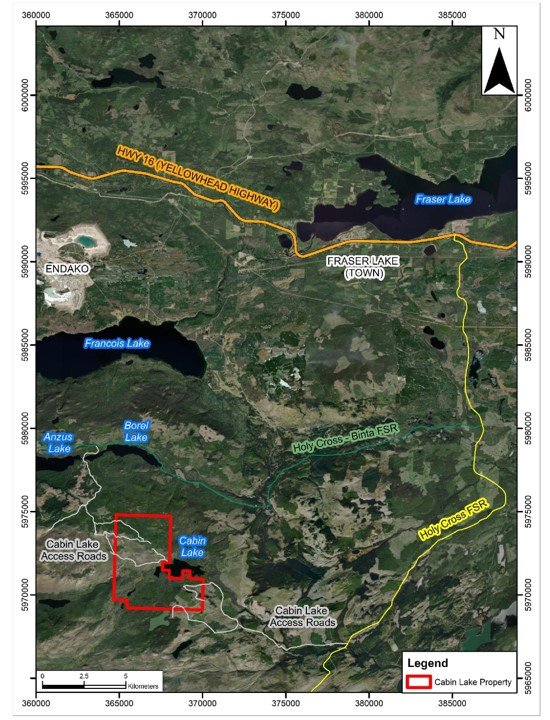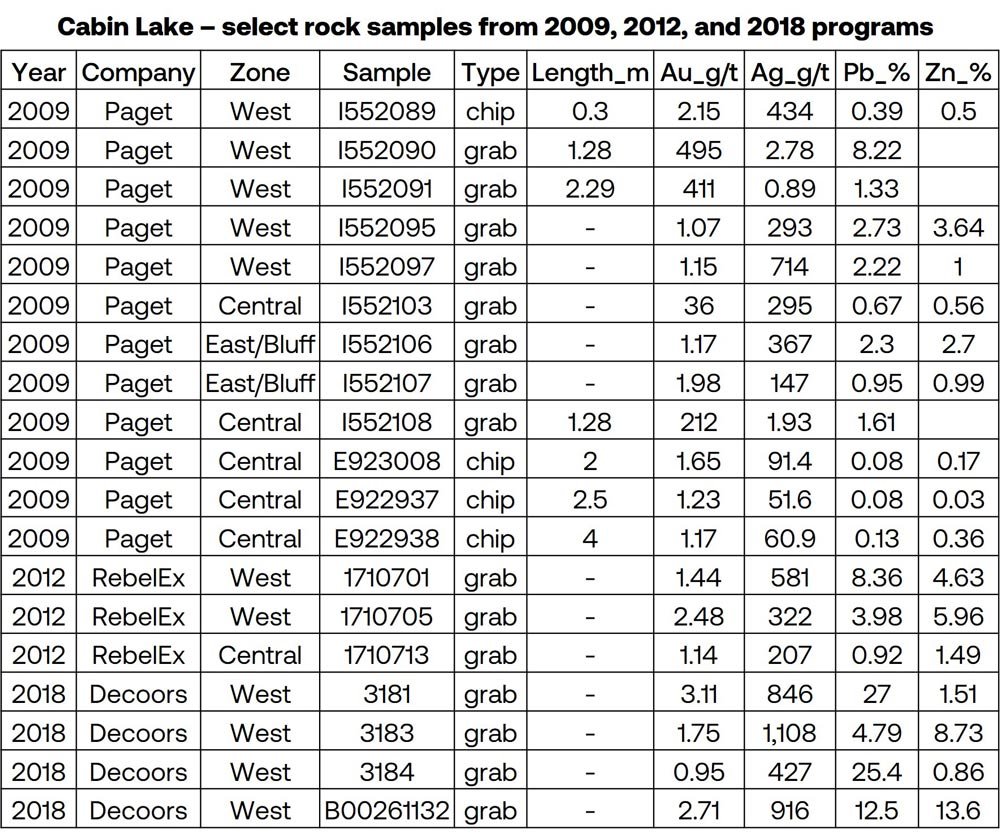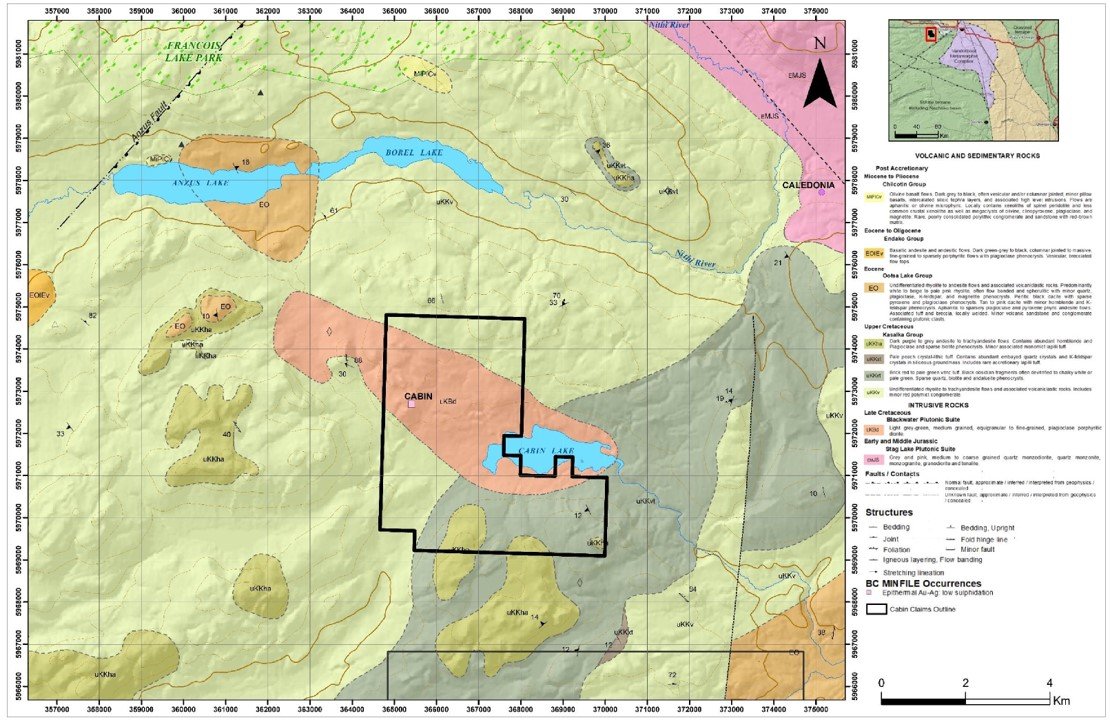Cabin Lake
Epithermal Silver Lead Zinc Veins - Blackwater Mine Area
The Cabin Lake Property has been optioned.
Introduction
The Cabin Lake Au-Ag-Cu-Pb-Zn project is located in the Nechako Basin of central British Columbia, 80 km north of Artemis Gold’s Blackwater epithermal gold-silver deposit and 16 km south of Thompson Creek’s Endako molybdenum mine.

Cabin Lake Location Map
Work at Cabin Lake has focused on a 600m x 1,000m zone of quartz-sericite-pyrite alteration cut by mineralized veins, stockworks, and breccias with significant gold, silver, lead, and zinc values. Five main north-trending mineralized structures have been identified to date across a width of 1,000 m. The mineralized structures are exposed in a series of trenches dating back to the 1960s and are open along strike under glacial cover. The best exposed structure, Zone E, has been traced discontinuously over a strike length of 415 m.
Geology
The Cabin Lake Property is situated along the Stikine island arc terrane within the Intermontane Belt. Since the accretion of the Stikine Terrane onto the North American margin (ca. 175 Ma; Nelson and Colpron, 2007), the BC Cordillera has been an active site of continental arc magmatism and volcanic activity. Several episodes of volcanic arc activity have been identified. During the Late Jurassic-Early Cretaceous, intrusions and volcanism occurred subsequent to terrane accretion. The mid-Cretaceous was a time of considerable plutonic activity and the formation of the Coast Plutonic Complex. During the Late Cretaceous, magmatic activity decreased and migrated eastward into the western Nechako Plateau region and was associated with the emplacement of the Blackwater, Bulkley, and Capoose intrusions and the formation of the Kasalka volcanics (Friedman et al., 2001).
The Stikine terrane is endowed with Mesozoic to Paleogene epithermal and porphyry deposits. Pastproducing porphyries include the Huckleberry Cu-Au-Mo calc-alkalic porphyry mine near Houston, associated with the Late Cretaceous Bulkley Intrusive Suite (Friedman and Jordan, 1997), and the Endako Mo porphyry mine hosted in the Late Jurassic Francois Lake Suite (Villeneuve, 2001). Epithermal and vein mineralization is best documented by the Blackwater, Capoose, Holy Cross, Equity Silver, Silver Queen, and Newton deposits. These are associated with hydrothermal activity related to Late Cretaceous magmatism in Kasalka volcanics.
The Cabin Lake property is underlain by Upper Cretaceous Kasalka Group volcanics and the Late Cretaceous Blackwater Suite Cabin Lake Pluton. The Cabin Lake and Blackwater Kasalka localities produce almost identical patterns in most major, trace, and rare earth element plots (Kim, 2020).
Mineralization
The Cabin Lake showings are characterized by intensely silicified granodiorite with heavy manganese staining on fractures. Mineralized veins contain galena, sphalerite, pyrite, chalcopyrite, covellite, arsenopyrite, and tennantite in a gangue of grey to white cryptocrystalline to fine drusy quartz. Galena is the main ore mineral and occurs as fine to coarse disseminations and massive sulphide bands up to 3 cm thick. Sphalerite is disseminated throughout, however occurs dominantly peripheral to galena-rich zones in thin bands. Pyrite-chalcopyrite occurs in discrete bands and as disseminations within galena and gangue minerals. Covellite is observed in patches proximal to chalcopyrite and may be a product of surface weathering. Veins are often zoned, with central semi-massive to massive galena with peripheral sphalerite zones and outer pyrite-chalcopyrite-covellite bands.
In 2009, after regional exploration on a Nechako joint venture, Paget geologists selected the Cabin Lake project as a property for further exploration. A total of 72 rock chip and grab samples taken from the mineralized areas averaged 0.96 g/t Au, 73.4 g/t Ag, 0.46% Zn, and 0.36% Pb.

Recent work has identified a large magnetic low just north of the Cabin Lake mineralized zones within Geoscience B.C.’s TREK Magnetic dataset. This low, within Cabin Lake Blackwater suite intrusive, is a high priority exploration target. 2 additional targets have also been identified along strike of Cabin’s northwest mineralization trend within Kasalka volcanics.
Cabin Gallery







